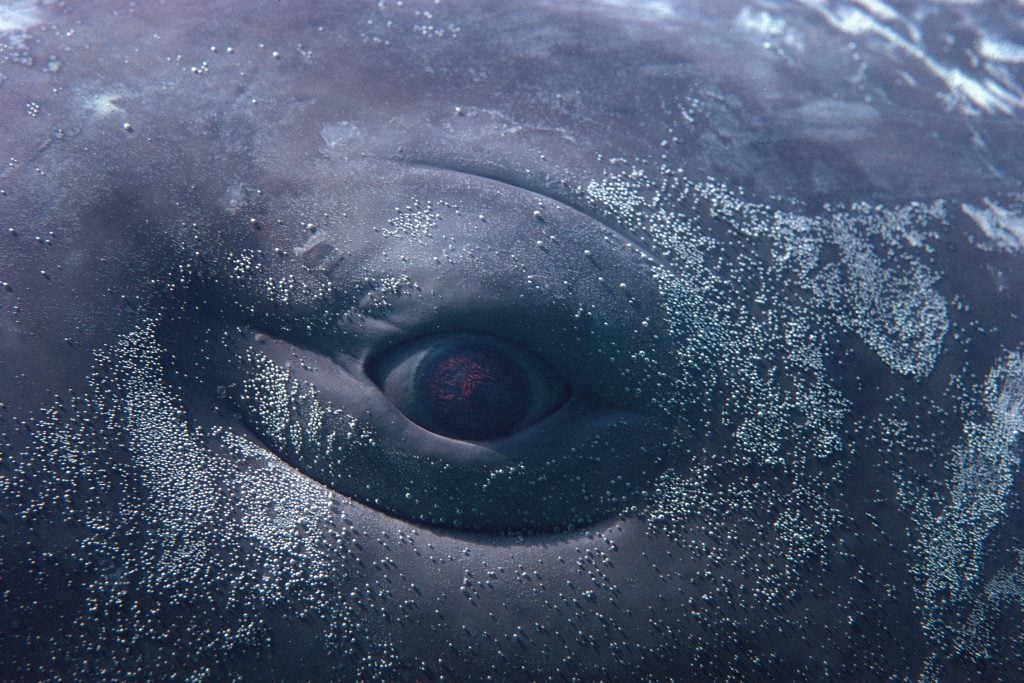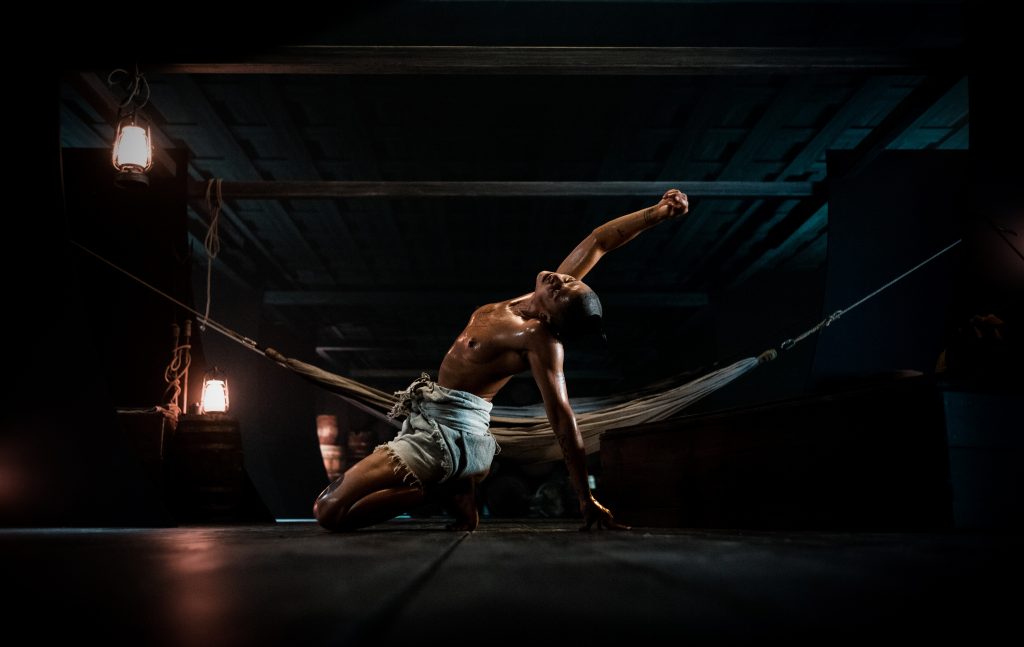People
Artist Wu Tsang Dives Into the Depths of ‘Moby Dick’ With Three Simultaneous Shows About Melville’s ‘Flamboyant, Queer’ Saga
The works are on view at the Venice Biennale, the Whitney Biennial, and the Shed.

The works are on view at the Venice Biennale, the Whitney Biennial, and the Shed.

Osman Can Yerebakan

“I hope this whale stays here,” said the artist Wu Tsang on a recent afternoon in Venice. She pointed to a tiny marble whale that she had placed on the narrow stone walkway that divided the sea outside the Arsenale, where the 59th Venice Biennale opened last week.
We sat in the open Mediterranean air to watch one of Tsang’s contributions to the event, Of Whales, a real-time film installation projected onto a 57-foot-wide screen under the arches of the Gaggiandre, a secluded 16th-century shipping yard.
The site-specific digital film displays a six-hour loop of dreamlike subaquatic sequences and changing reflections of daylight, woven together through the use of game engine technology. It is surrounded by a 32-channel sound installation, all of which was created in collaboration with the immersive, technology-focused art organization VIVE Arts.
Tsang’s miniature toy, halved into a tail and a body, was in fact the only whale in sight since the film imagines the story of Herman Melville’s Moby-Dick from the whale’s perspective. It was a gift from the artist Sophia Al Maria, who wrote the screenplay for a companion work by Tsang in the biennale, the feature film MOBY DICK; or, The Whale.
“Sophia first gave me its tail when we began writing the script and, more recently, the body,” she said, just as the two films are matching parts of one tale.

Wu Tsang, MOBY DICK; or, The Whale (2022). Photo: Design Pics Inc/ Alamy.
The 75-minute silent feature MOBY DICK; or, The Whale, which had its Venice premiere last Wednesday at Teatro Goldoni, following its U.S. premier at the Shed a week earlier, also looks at Melville’s Great American Novel, and it flips the vantage point once again.
Tsang took inspiration from CLR James’s 1953 book Mariners, Renegades, and Castaways: The Story of Herman Melville and the World We Live In, which looks at the Moby-Dick through the lens of colonialist greed and 1950s social hierarchy. “I saw many elements about what we are today and what we do to the Earth in the depictions of whale-hunting and oil extracting, which in one way led to the Industrial Revolution,” Tsang said.
Only then did Tsang finally read Melville’s classic (even though her English teacher mother had been suggesting it for years while she was growing up). The haunting presence of an unpredictable white sperm whale, and an entire chapter about the whiteness of the mammal, prompted Tsang to consider the color in terms of its social connotations today. Melville’s line about how “the hue strikes more panic in the soul” was a moment of revelation, she said.

Production still from MOBY DICK or, The Whale (2022) featuring Tosh Basco as Queequeg. Directed by Wu Tsang. Photo: Greg Amgwerd.
Yet another extension of the project, EXTRACTS, is on view now in the Whitney Biennial in New York. For the performance and video installation, Tsang, as part of the Zurich-based art collective Moved by the Motion, chronicled the making of the feature film with archival imagery and cut scenes of dancing. Like the film’s scenes of oil extraction, EXTRACTS also a meditates on the potentiality of refusal, extraction, and rebirth.
“The work has allowed us to collaboratively use the dancing and choreography that went into the creation of the movie but did not make it to the final cut,” Tsang said.
“The work is about reflection in both senses, as well as capturing the whale come out of the water and dive back into it,” the artist said, looking at the looping underwater scenes in which the whale remains unseen but is hinted at in fluctuating camera movements. Images of jellyfish float through the water and spiral beams of light reflect across forceful waves. A meditative soundtrack by Tsang’s frequent collaborator, musician Asma Maroof, fills the space with a symphonic blend of saxophone, trumpet, horns, flute, clarinet, and contrabass.
For OF WHALES, which Tsang considers “the second verse” of her Moby-Dick project, she wanted to bring in the non-human perspective of a story famously about human greed. During her visits to Venice Biennales in the past, Tsang would always find herself perched under that shipyard’s glorious arches, chatting with friends.

Wu Tsang, Of Whales (2022), with VIVE Arts VIA Art Fund, LUMA Foundation, ATLAS V, Albyon Studio. Courtesy the Artist, Galerie Isabella Bortolozzi, Berlin, Antenna Space, Shanghai, Cabinet, London. Photo: Matteo De Fina.
Curator Cecilia Alemani’s focus on artworks concerned with humankind’s precarious relationship with nonhumans for this year’s Biennale provided Tsang the perfect context. “When Cecilia invited me to join the biennial in this particular space, I didn’t want to just put a movie on the screen,” the artist said. “I wanted to bring something special for such a special place and allow people to have their own contemplations about the whale.” With its seclusion from the rest of the show, the site elevates the film’s themes of aquatic transcendence and the otherworldly equilibrium of sea creatures.
Another theme that informed this body of work is Melville’s “flamboyant, queer, and juicily layered” language, she said. “Melville makes detailed descriptions of the sailors’ physiques and how their bodies form while they use the harpoon, which allowed us, a whole queer cast and crew, to play on hyper-masculinity.”
Tsang has long been known for her explorations of queer spatiality and solidarity in film and sculpture, with works such as Wildness (2012) or Duilian (2015), and her Moby-Dick projects see the book’s intertwined themes of male ambition and weakness as sites for a queer reading. (Rainer Werner Fassbinder’s 1982 homoerotic marine fantasy Querelle, which the German auteur adapted from Jean Genet’s novel Querelle of Brest, is another influence, with its unabashedly theatrical representation of sea life.)
MOBY DICK; or, The Whale, which was supported by the Swiss theater Schauspielhaus Zürich, where Tsang currently lives, stars Tsang’s frequent collaborators, performance artist Tosh Basco, also known as boychild, and poet Fred Moten. Telfar and Kyle Luu designed the costumes, which transform the characters’ late 19th-century marine attire into a gender nonconforming, nightlife-inspired style.
In the fall, Tsang will shift gears to stage a version of Pinocchio at the Schauspielhaus. But it’s not a complete departure: “There is a big whale in there, too!” she said. “I am not really done with it yet—there is more deep in the whale.”